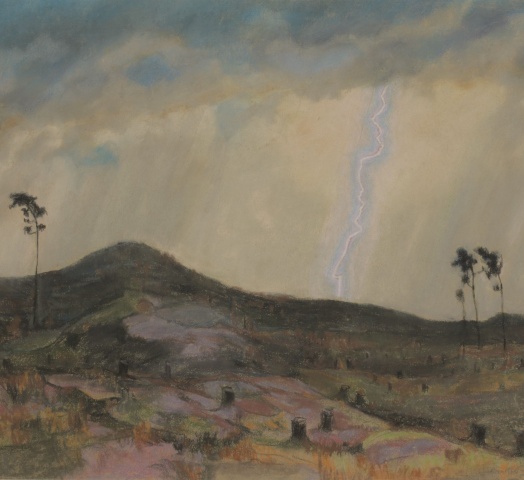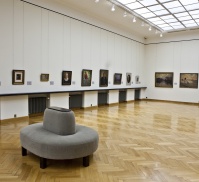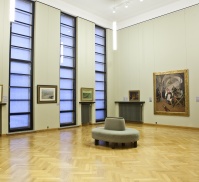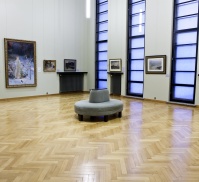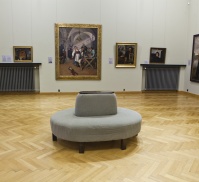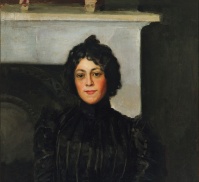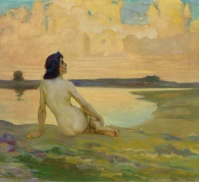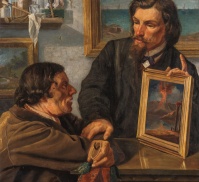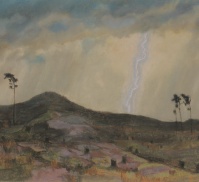THE BREAK OF DAWN. LITHUANIAN VISUAL ARTS PRIOR TO 1918
Opening of the exhibition “The Break of Dawn. Lithuanian Visual Arts prior to 1918” upcoming at M. K. Čiurlionis National Museum of Art (V. Putvinskio St. 55, Kaunas) on 10th of May at 5 p.m.
The break of dawn is the time of feeling that in a few instants all the life is bound to awaken with the power and strength of a brand new day. Such words as the dawn, the time before dawn or the break of dawn have already established themselves as synonyms of the revival of the Nation.
The idea for the exhibition The Break of Dawn. Lithuanian Visual Arts prior to 1918 stemmed from the wish to introduce to the society the works of art of the beginning of the 20th century which are most significant to the contemporary culture of Lithuania stored at M.K. Čiurlionis National Museum of Art and in private collections. The intention of the organizers was to unite the art research and historical materials thus recreating in the halls of the museum the volatile spirit of the times.
The cultural movement of the early 20th century produced the fundamental push towards the formation of the Lithuanian independence. The aspirations of the national independence and the ethnic identity matured in the cultural environment. The dawn of ethnic consciousness came with the understanding that without moral values the nation would head towards extinction. Novel objectives, challenges and ambitions developed – to speak, read, sing and write in Lithuanian. Thus the claim that visual arts were not involved into the general cultural environment (as well as the awakening of conscience) at all – or it was just scarcely involved – would not be perfectly correct.
The first Lithuanian Art Exhibition is one of the most passionate art events in the 20th century Lithuania; it is the very beginning stemming from the initiative of young artists. This was the key development of the time supported by the intellectuals and implemented by a tightly knit team of alike minds – Petras Rimša, Antanas Žmuidzinavičius, Mikalojus Konstantinas Čiurlionis, Marija Putvinskaitė, Sofija Gimbutaitė and Ona Pleirytė-Puidienė. The founding of the Lithuanian Art Society altered the history of art in Lithuania and served as the foundation of the modern art of today.
The Society united the elite for joint work, it published various editions, held competitions, sought financial support for people doing creative work, raised funds and dreamt of a modern Palace of the Lithuanian Nation featuring museum and concert spaces. Painters from various European countries would send their works. Professional works would be exhibited beside pieces of folk art. It was at that time that the understanding of the ‘village craft’ developed. The initial exhibitions provided an opportunity for getting to know and promoting folk art not only within the territory of Lithuania but also beyond the borders. Art was awakening the society, and the innovative genre of analytical Impressionist criticism found its source in the contemporary mass media.
With the passing of a century, it is important to recheck the significance of the idea of Czesław Miłosz, the winner of the Nobel Prize in Literature, about Europe consisting of “small homelands” – when we need to support ourselves, when we are required to learn from the past of our nation and to draw our strength from our history while seeking continuity of moral values. It is fundamental that each of us should ask a question: was it relevant only at that time, one hundred years ago, or is it still relevant today? What were the ideas of the young people of the early 20th century studying at art schools, academies or universities in Saint Petersburg, Krakow, Warsaw, Munich or Paris? Having arrived from a poor country into the Maelstrom of world cultures, being enchanted by progress, how did they survive, how did they manage to unite, to form groups, to support each other when, while suffering from incessant hunger, they were still thinking about their Homeland and the ways of dedicating their efforts to the Homeland?
Organiser: Nacionalinis M. K. Čiurlionio dailės muziejus
Lenders to the exhibition: Ellex Valiunas, dr. Jaunius Gumbis, Dalia Ona Zubovaitė-Palukaitienė, Aidas Rimša, Mykolas Okulič-Kazarinas, „Lewben Art Foundation“, Lietuvos bankas, Lietuvos dailės muziejus.
Exhibition works: 10 05 2018–31 06 2019
Photos Audrius Kapčius

Opening of the exhibition “The Break of Dawn. Lithuanian Visual Arts prior to 1918” upcoming at M. K. Čiurlionis National Museum of Art (V. Putvinskio St. 55, Kaunas) on 10th of May at 5 p.m.
The break of dawn is the time of feeling that in a few instants all the life is bound to awaken with the power and strength of a brand new day. Such words as the dawn, the time before dawn or the break of dawn have already established themselves as synonyms of the revival of the Nation.
The idea for the exhibition The Break of Dawn. Lithuanian Visual Arts prior to 1918 stemmed from the wish to introduce to the society the works of art of the beginning of the 20th century which are most significant to the contemporary culture of Lithuania stored at M.K. Čiurlionis National Museum of Art and in private collections. The intention of the organizers was to unite the art research and historical materials thus recreating in the halls of the museum the volatile spirit of the times.
The cultural movement of the early 20th century produced the fundamental push towards the formation of the Lithuanian independence. The aspirations of the national independence and the ethnic identity matured in the cultural environment. The dawn of ethnic consciousness came with the understanding that without moral values the nation would head towards extinction. Novel objectives, challenges and ambitions developed – to speak, read, sing and write in Lithuanian. Thus the claim that visual arts were not involved into the general cultural environment (as well as the awakening of conscience) at all – or it was just scarcely involved – would not be perfectly correct.
The first Lithuanian Art Exhibition is one of the most passionate art events in the 20th century Lithuania; it is the very beginning stemming from the initiative of young artists. This was the key development of the time supported by the intellectuals and implemented by a tightly knit team of alike minds – Petras Rimša, Antanas Žmuidzinavičius, Mikalojus Konstantinas Čiurlionis, Marija Putvinskaitė, Sofija Gimbutaitė and Ona Pleirytė-Puidienė. The founding of the Lithuanian Art Society altered the history of art in Lithuania and served as the foundation of the modern art of today.
The Society united the elite for joint work, it published various editions, held competitions, sought financial support for people doing creative work, raised funds and dreamt of a modern Palace of the Lithuanian Nation featuring museum and concert spaces. Painters from various European countries would send their works. Professional works would be exhibited beside pieces of folk art. It was at that time that the understanding of the ‘village craft’ developed. The initial exhibitions provided an opportunity for getting to know and promoting folk art not only within the territory of Lithuania but also beyond the borders. Art was awakening the society, and the innovative genre of analytical Impressionist criticism found its source in the contemporary mass media.
With the passing of a century, it is important to recheck the significance of the idea of Czesław Miłosz, the winner of the Nobel Prize in Literature, about Europe consisting of “small homelands” – when we need to support ourselves, when we are required to learn from the past of our nation and to draw our strength from our history while seeking continuity of moral values. It is fundamental that each of us should ask a question: was it relevant only at that time, one hundred years ago, or is it still relevant today? What were the ideas of the young people of the early 20th century studying at art schools, academies or universities in Saint Petersburg, Krakow, Warsaw, Munich or Paris? Having arrived from a poor country into the Maelstrom of world cultures, being enchanted by progress, how did they survive, how did they manage to unite, to form groups, to support each other when, while suffering from incessant hunger, they were still thinking about their Homeland and the ways of dedicating their efforts to the Homeland?
Organiser: Nacionalinis M. K. Čiurlionio dailės muziejus
Lenders to the exhibition: Ellex Valiunas, dr. Jaunius Gumbis, Dalia Ona Zubovaitė-Palukaitienė, Aidas Rimša, Mykolas Okulič-Kazarinas, „Lewben Art Foundation“, Lietuvos bankas, Lietuvos dailės muziejus.
Exhibition works: 10 05 2018–31 06 2019
Photos Audrius Kapčius






